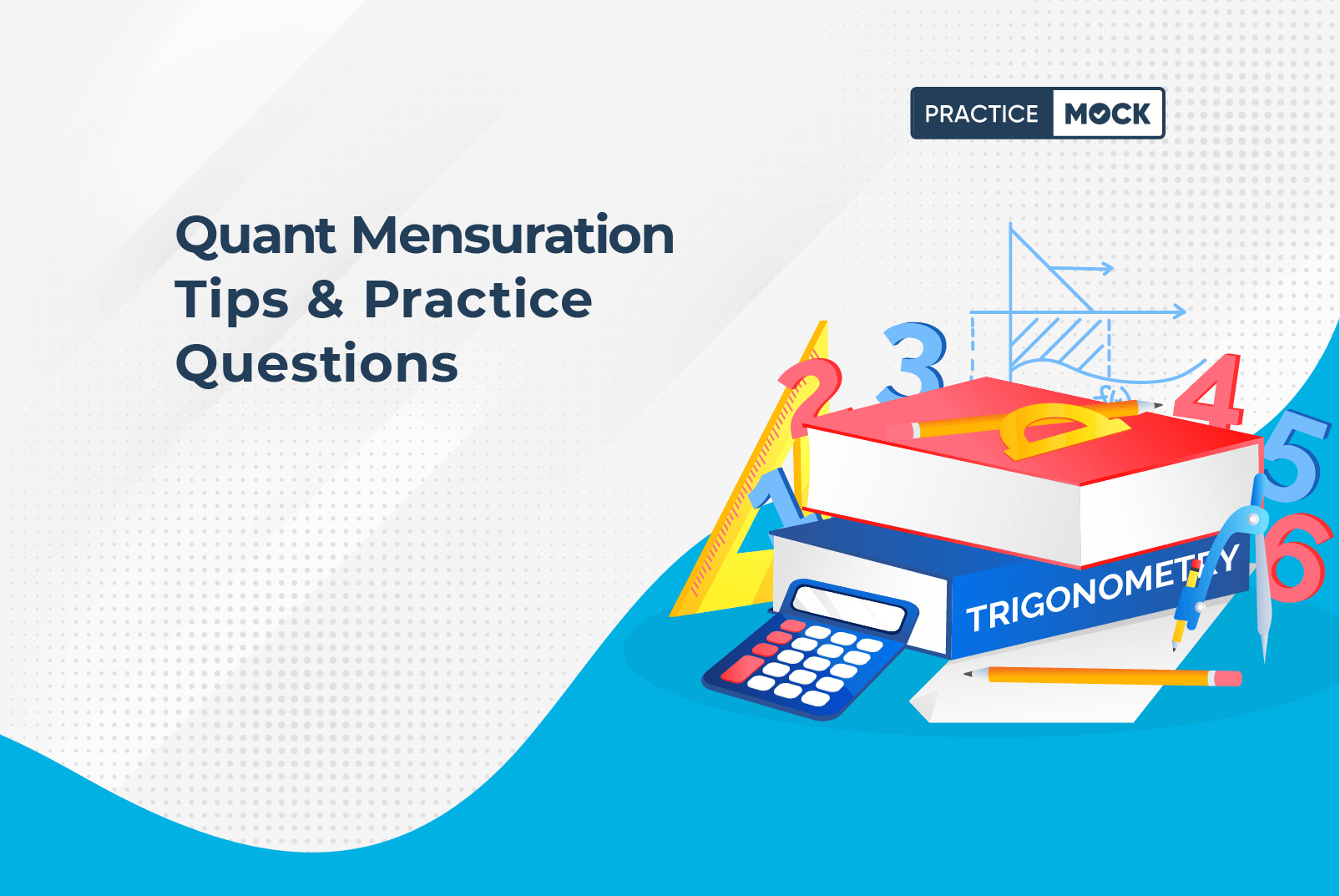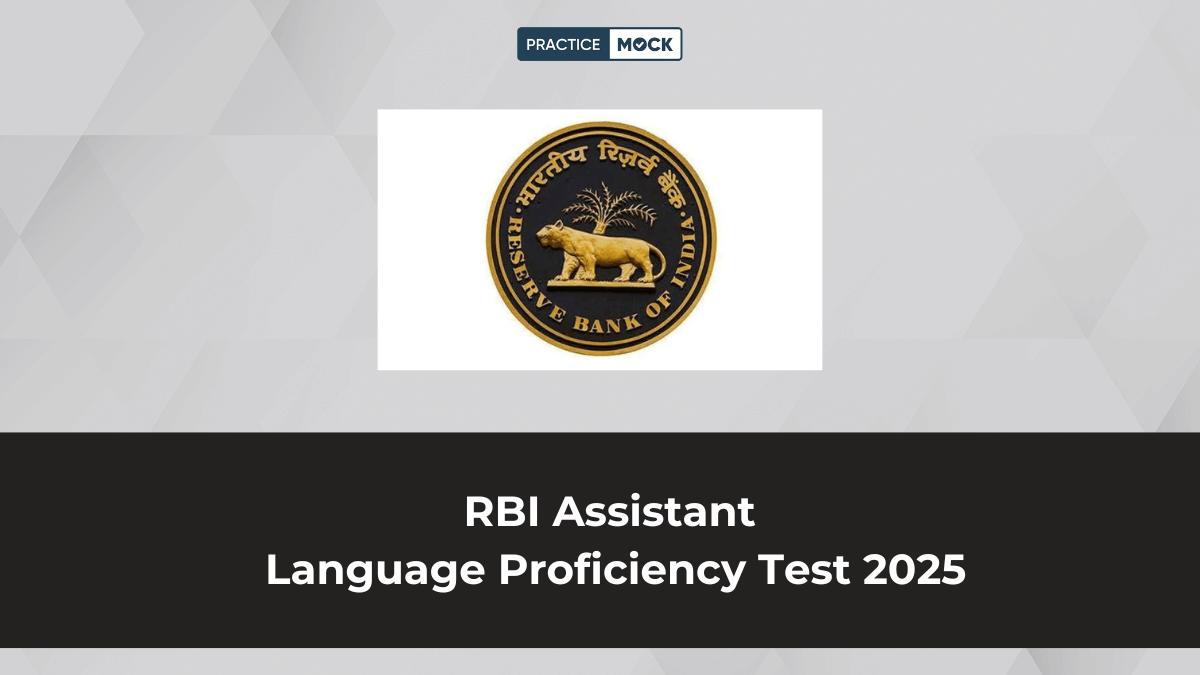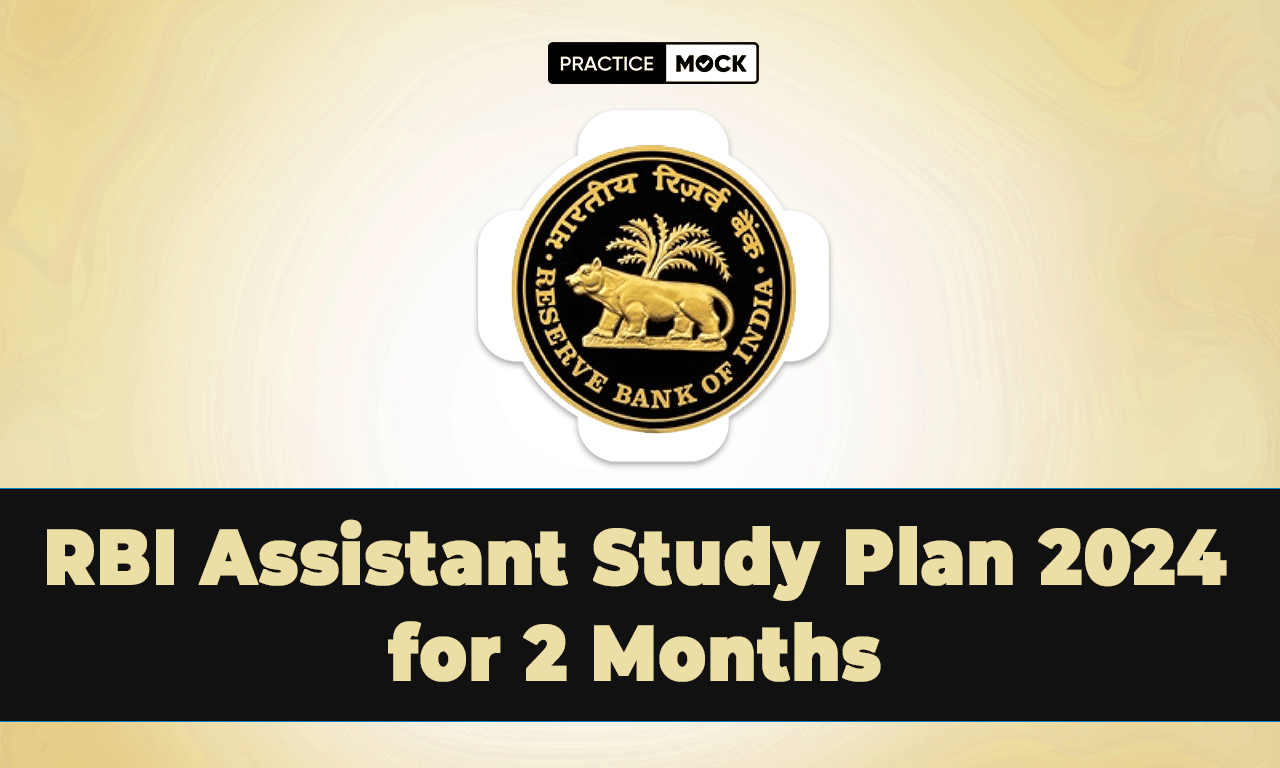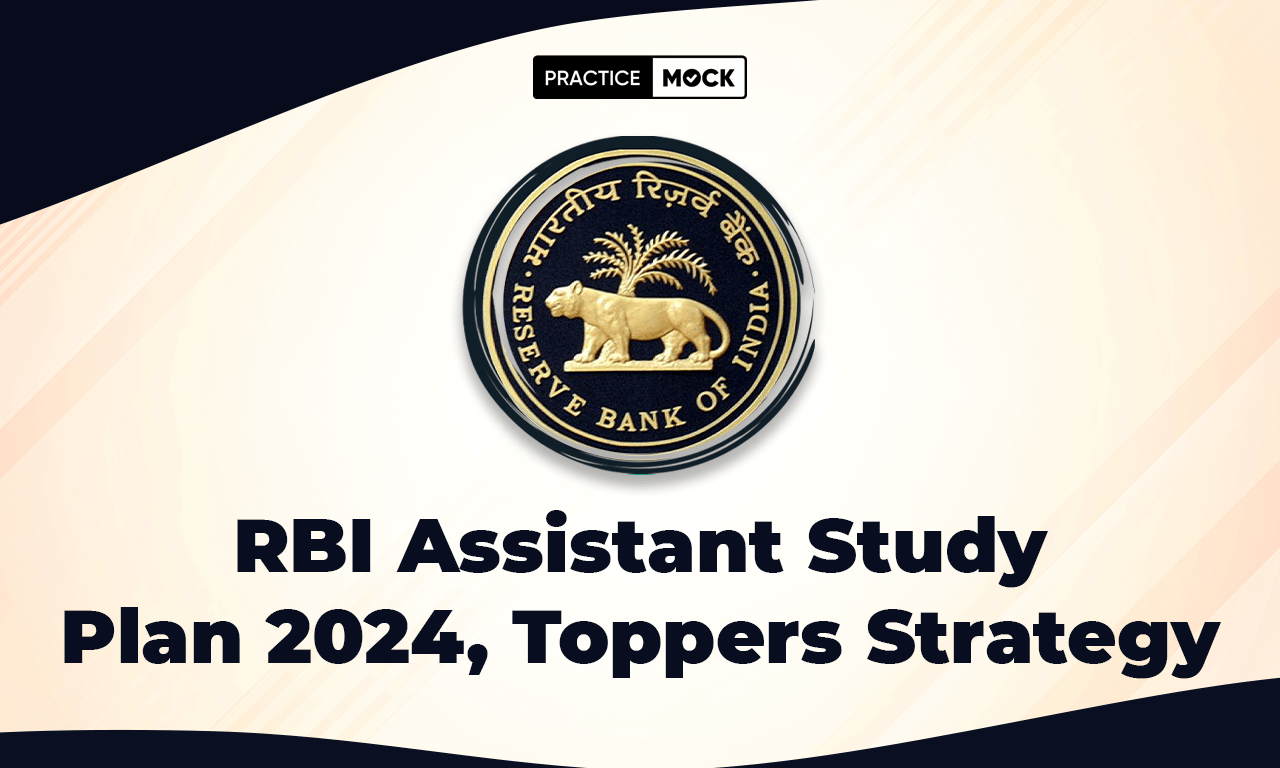Quant Mensuration Tips & Practice Questions


Mensuration is yet another important concept for banking exam preparation and is the study of different dimensions including length, breadth, height, area, and volume of various geometric shapes. These kinds of questions contain a significant weightage in bank exams and thus, candidates must learn good preparation strategy in order to ace the exams especially the one which is coming up that is RBI Assistant prelims exam. We are here with a quick revision of a few Quant Mensuration Tips & Practice Questions.
Mensuration:
Mensuration deals with measurement of areas and volumes of different figures. These figures include both ‘2D’ (two dimensional) and ‘3D’ (three dimensional) figures (also known as solids).
Note: By definition, ‘2D’ figures exist in a two dimensional world and hence have no volume.
Let’s take a brief look at the formulae for areas of various ‘2D’ figures, and areas and volumes of ‘3D’ figures.
2D Figures:
Polygons: A Polygon is a closed figure made up of at least 3 line segments in a two-dimensional plane.
Triangle: A triangle is a polygon containing 3 sides. The area of a triangle is represented by the figure Δ.
Formulas associated with triangles:
Area:
I. For any triangle in general;
For a triangle having sides of length ‘a’ cm, ‘b’ cm and ‘c’ cm;
Perimeter of triangle = Sum of length of three sides = (a + b + c) cm.
Area = √{s × (s – a) × (s – b) × (s – c)}
Where ‘s’ is the semi-perimeter of the triangle. ‘s’ = {(a + b + c)/2}
This formula is universally known as heron’s formula.
II. For a triangle whose length of base and length of altitude (Height) to that base is given;
Area = (1/2) × base × height
III. Equilateral triangle: If all three sides of a triangle are equal, then it is an equilateral triangle.
For an equilateral triangle with side ‘a’ cm, Area = (√3/4) × a2
Using (II), we have; (1/2) × a × height = (√3/4) × a2
Or, height = (√3/2) × a
IV. Isosceles triangle: If any two sides of a triangle are equal, then it is an isosceles triangle.
Area = (a/4)√(4c2 – a2) {where ‘c’ is the length of each of the two equal sides and ‘a’ is the length of the third (un-equal) side}
RBI Assistant prelims free mock test
Quadrilaterals: Any polygon having for sides is called a quadrilateral.
I. Area of a normal quadrilateral with vertices ‘A’, ‘B’, ‘C’ and ‘D’ (As shown in the figure)
Area of quadrilateral ABCD = (1/2) × Length of BD × (AF + DE), where AF and DE are perpendicular to BC.
II. Trapezium: A trapezium is a quadrilateral having exactly two parallel sides.
Area of trapezium = (1/2) × sum of parallel sides × Height of the trapezium.
III. Parallelogram: A parallelogram is a quadrilateral whose opposite sides are parallel as well as equal to each other.
Area = length of base × height (perpendicular distance)
IV. Square: A square is a parallelogram whose all four sides are of equal length and angles are of 90o each.
Area = (a)2 {where ‘a’ is the length of each side}
V. Rhombus: A Rhombus is a parallelogram whose all four sides are equal.
Area = (1/2) × product of length of diagonals
VI. Rectangle: A rectangle is a parallelogram that has all four angles of 90o
For a rectangle with length ‘L’ cm and Breadth ‘B’ cm,
Area = L × B
And, Perimeter = 2(L + B)
Circle:
For a circle with radius ‘r’ units
Area = πr2
Circumference = 2πr
Area of sector = (θo/360o) × πr2 {Where θ is the angle subtended inside the sector}
Length of arc = (θo/360o) × 2πr
RBI Assistant prelims free mock test
Area and Volumes of solids:
Cube: A cube is a solid shape with six square faces.
Total surface area of cube = 6a2 {Where ‘a’ is the length of edge of the cube}
Volume of cube = a3
Cuboid: A cuboid is bound by 6 rectangular faces. The opposite faces of a cuboid are equal rectangles lying in parallel planes.
Volume of a cuboid with length ‘x’ cm, breadth ‘y’ cm and height ‘h’ cm = (x × y × h)
Total surface area of cuboid = 2(xy + yh + xh)
Lateral surface area of a cuboid = 2xh + 2yh = 2h(x + y)
Cone: A cone is a solid which has a circle at its base and a slanting lateral surface that converges at the apex.
Curved surface area of the cone = π × r × s {Where ‘r’ is radius and ‘s’ is slant height}
Slant height of a cone = √(r2 + h2), where ‘h’ is height of the cone.
Total surface area of cone = Curved surface area + area of base = πrs + πr2 = πr(r + s)
Frustum of a cone: If a cone is cut into two parts by a plane parallel to the base, the portion with the upper tip of the cone still remains a cone; however the portion that contains the base is called the frustum of the cone.
Curved surface area of frustum = π × s(R + r) {Where ‘s’ is slant height ,‘R’ is radius of the base and ‘r’ is the radius of the top.}
Total surface area of the frustum = π(R2 + r2 + Rs + rs)
Volume of the frustum = (1/2) × π × h × {R2 + r2 + Rr} {Where ‘h’ is the height of the cone}
s2 = (R2 – r2) + h2
Cylinder: Cylinder is a three-dimensional solid that holds two parallel bases joined by a curved surface, at a fixed distance.
Curved surface area of a cylinder = 2πrh {Where ‘r’ is the radius of the base and ‘h’ is the height of the cylinder}
Total surface area of the cylinder = 2πrh + 2πr2 = 2πr(r + h)
Volume of cylinder = πr2h
RBI Assistant prelims free mock test
Sphere: Sphere is a three dimensional solid, that has all its surface points at equal distances from the centre. The distance between the centre and a surface point of the sphere is called its radius (r).
Volume of sphere = (4/3) × πr3
Surface area of a sphere = 4πr2
Hemisphere: Where a sphere is divided into two equal and identical parts, the new formed parts are called hemispheres.
Volume of hemisphere = (2/3)πr3
Total surface area of hemisphere = 3πr2
Curved surface area of hemisphere = 2πr2
RBI Assistant prelims free mock test
Quant Mensuration Tips & Practice Questions
Question 1: If circumference of the base of a right circular cone is 220 cm and volume of the cone is 15400 cm3, then slant height of the cone is:
A) 39 cm
B) 38 cm
C) 41 cm
D) 37 cm
E) None of these
Question 2: The difference between the length and breadth of a rectangular field is 27 m. If the cost of fencing the field at the rate of Rs. 2/metre is Rs. 492, then find the ratio of the length to breadth of the field.
A) 26:15
B) 24:17
C) 2:1
D) 12:5
E) 25:16
Question 3: A cube having each edge equals to 20 cm is cut into several smaller cubes having each edge equals to 4 cm. Find the number of smaller cubes which are the part of the faces of the larger cube but not the part of edges of the larger cube.
A) 56
B) 64
C) 32
D) 54
E) 72
RBI Assistant prelims free mock test
Question 4: Each side of square ‘A’ is 6 cm less than that of square ‘B’. The perimeter of a rectangle is 3 times the difference of the perimeters of the two squares. If the length of the rectangle is 20 cm, then find its breadth.
A) 19 cm
B) 14 cm
C) 12 cm
D) 18 cm
E) None of these
Question 5: Ratio of radius to height of right circular cylinder is 4:9 respectively. Find the area of a rectangle whose breadth is 37.5% more than radius of the cylinder while ratio of length of rectangle to height of cylinder is 3:4 respectively. Given that curved surface area of the cylinder is 3456 cm2. (Take π = 3)
A) 884 cm
B) 584 cm2
C) 594 cm2
D) 624 cm2
E) None of these
Question 6: The diagonal of a square is 24√2 cm. The perimeter of the square is 24 cm less than a rectangle whose length to breadth ratio is 7:5. Find the area of the rectangle.
A) 725 cm2
B) 875 cm2
C) 915 cm2
D) 625 cm2
E) 1015 cm2
Question 7: The ratio of length to breadth of a rectangle is 8:5. When the length and breadth of the rectangle is increased by 25% and decreased by 40% respectively, then its perimeter becomes 390 cm. Find the original area of the rectangle.
A) 8400 cm2
B) 9000 cm2
C) 7200 cm2
D) 6400 cm2
E) 10500 cm2
RBI Assistant prelims free mock test
Question 8: The perimeter of a square is 36 metres more than that of a rectangle. The ratio of the length to breadth of the rectangle is 9:4. If the area of the square is 3721 m2, then find the cost of painting one surface of the rectangle at the rate of Rs. 2.5/m2.
A) Rs. 5760
B) Rs. 4320
C) Rs. 5220
D) Rs. 6300
E) Rs. 5040
Question 9: Volume of a cylinder is 4928 m3 while cost of painting its outer surface (except base and top) at a rate of Rs. 8 per m2 is Rs. 5632. Find the ratio of radius of base to height of the cylinder.
A) 7:6
B) 7:8
C) 7:4
D) 7:2
E) None of these
Question 10: Area of the base of a cone is 616 cm2 and curved surface area of a cylinder is 3168 cm2. Find the height of the cylinder if radius of base of cylinder is 4 cm more than that of the cone.
A) 21 cm
B) 35 cm
C) 28 cm
D) 24 cm
E) None of these
RBI Assistant prelims free mock test
प्रश्न 1: यदि एक लंब वृत्तीय शंकु के आधार की परिधि 220 cm है और शंकु का आयतन 15400 cm3 है, तो शंकु की तिर्यक ऊंचाई कितनी है:
A) 39 cm
B) 38 cm
C) 41 cm
D) 37 cm
E) None of these
प्रश्न 2: एक आयताकार मैदान की लंबाई और चौड़ाई के बीच का अंतर 27 m है। यदि Rs. 2/metre की दर से मैदान में बाड़ लगाने की लागत Rs. 492 है, तो मैदान की लंबाई और चौड़ाई का अनुपात ज्ञात कीजिए।
A) 26:15
B) 24:17
C) 2:1
D) 12:5
E) 25:16
प्रश्न 3: एक घन, जिसकी प्रत्येक भुजा 20 cm के बराबर है, को कई छोटे घनों में काटा जाता है, जिनमें से प्रत्येक की भुजा 4 cm के बराबर होता है।उन छोटे घनों की संख्या ज्ञात कीजिए जो बड़े घन के फलक का भाग हैं लेकिन बड़े घन के भुजाओं का भाग नहीं हैं।
A) 56
B) 64
C) 32
D) 54
E) 72
प्रश्न 4: वर्ग ‘A’ की प्रत्येक भुजा वर्ग ‘B’ की भुजा से 6 cm कम है। एक आयत का परिधि दो वर्गों की परिधि के अंतर का तीन गुना है। यदि आयत की लंबाई 20 cm है, तो इसकी चौड़ाई ज्ञात कीजिए।
A) 19 cm
B) 14 cm
C) 12 cm
D) 18 cm
E) इनमें से कोई नहीं
RBI Assistant prelims free mock test
प्रश्न 5: एक लम्ब वृत्तीय बेलन की त्रिज्या और ऊंचाई का अनुपात क्रमशः 4:9 है। एक आयत का क्षेत्रफल ज्ञात कीजिए जिसकी चौड़ाई बेलन की त्रिज्या से 37.5% अधिक है जबकि आयत की लंबाई और बेलन की ऊंचाई का अनुपात क्रमशः 3:4 है। दिया गया है कि बेलन का वक्र पृष्ठीय क्षेत्रफल 3456 cm2 है। (Take π = 3)
A) 884 cm
B) 584 cm2
C) 594 cm2
D) 624 cm2
E) इनमें से कोई नहीं
प्रश्न 6: एक वर्ग का विकर्ण 24√2 cm है। वर्ग का परिधी उस आयत से 24 cm कम है जिसकी लंबाई और चौड़ाई का अनुपात 7:5 है। आयत का क्षेत्रफल ज्ञात कीजिए।
A) 725 cm2
B) 875 cm2
C) 915 cm2
D) 625 cm2
E) 1015 cm2
प्रश्न 7: एक आयत की लंबाई और चौड़ाई का अनुपात 8:5 है। जब आयत की लंबाई और चौड़ाई में क्रमशः 25% की वृद्धि और 40% की कमी की जाती है, तो इसका परिमाप 390 cm हो जाता है। आयत का वास्तविक क्षेत्रफल ज्ञात कीजिए।
A) 8400 cm2
B) 9000 cm2
C) 7200 cm2
D) 6400 cm2
E) 10500 cm2
RBI Assistant prelims free mock test
प्रश्न 8: एक वर्ग का परिमाप एक आयत के परिमाप से 36 metres अधिक है। आयत की लंबाई और चौड़ाई का अनुपात 9:4 है। यदि वर्ग का क्षेत्रफल 3721 m2 है, तो Rs. 2.5/m2 की दर से आयत की एक सतह को रंगने की लागत ज्ञात कीजिए।
A) Rs. 5760
B) Rs. 4320
C) Rs. 5220
D) Rs. 6300
E) Rs. 5040
प्रश्न 9: एक बेलन का आयतन 4928 m3 है, जबकि इसकी बाहरी सतह (आधार और शीर्ष को छोड़कर) को Rs. 8 per m2 की दर से रंगने की लागत Rs. 5632 है। बेलन के आधार की त्रिज्या और ऊंचाई का अनुपात ज्ञात कीजिए।
A) 7:6
B) 7:8
C) 7:4
D) 7:2
E) इनमें से कोई नहीं
प्रश्न 10: एक शंकु के आधार का क्षेत्रफल 616 cm2 है और एक बेलन का वक्र पृष्ठीय क्षेत्रफल 3168 cm2 है। बेलन की ऊँचाई ज्ञात कीजिए यदि बेलन के आधार की त्रिज्या शंकु की त्रिज्या से 4 cm अधिक है।
A) 21 cm
B) 35 cm
C) 28 cm
D) 24 cm
E) इनमें से कोई नहीं
RBI Assistant prelims free mock test
ANSWER KEYS and SOLUTIONS:
| 1) – D) | 2) – E) | 3) – D) | 4) – E) | 5) – C) | 6) – B) |
| 7) – B) | 8) – A) | 9) – C) | 10) – C) |
Solution 1: D)
Let radius of the cone is ‘r’ cm.
So, 2πr = 220
Or, x = 35 cm
And, (1/3) × πr2h = 15400
Or, (1/3) × (22/7) × 35 × 35 × h = 15400
Or, h = 12 cm
So, slant height = √(122 + 352) = √1369 = 37 cm
Hence, option d.
Solution 2: E)
Let the length and breadth of the field be ‘l’ metres and ‘b’ metres, respectively
According to the question,
(l – b) = 27….. (1)
Also, perimeter of the rectangular field = 492/2 = 246
Or, 2(l + b) = 246
Or, (l + b) = 123…… (2)
On solving equation (1) and (2), we get
Length of the rectangle = l = 75 metres
Breadth of the field = b = 48 cm
Required ratio = 75:48 = 25:16
Hence, option e.
RBI Assistant prelims free mock test
Solution 3: D)
From each face of the larger cube, the number of smaller cubes obtained = (20 × 20)/(4 × 4) = 25
Total number of smaller cubes obtained from the edges of each face = 5 + 5 + 3 + 3 = 16 cubes
Therefore, number of smaller cubes obtained from each face that doesn’t lie on edge = 25 – 16 = 9
Required number of cubes = 9 × 6 = 54
Hence, option d.
Solution 4: E)
Let each side of the square ‘A’ be ‘a’ cm
Therefore, each side of square ‘B’ = (a + 6) cm
Difference between their perimeters = 4(a + 6) – 4a = 24 cm
Therefore, perimeter of the rectangle = 3 × 24 = 72 cm
Let the breadth of the rectangle be ‘b’ cm
According to the question,
2 × (20 + b) = 72
Or, 20 + b = 36
Or, b = 16 cm
Hence, option e.
Solution 5: C)
Let radius and height of the cylinder is ‘4x’ cm and ‘9x’ cm respectively.
According to question;
2πrh = 3456
2 × 3 × 4x × 9x = 3456
Or, x2 = 16
Or, x = 4
Radius of cylinder 4 × 4 = 16 cm
Breadth of rectangle = 1.375 × 16 = 22 cm
Height of cylinder = 4 × 9 = 36 cm
Length of rectangle = (3/4) × 36 = 27 cm
Area of the cylinder = 22 × 27 = 594 cm2
Hence, option c.
Solution 6: B)
Let each side of the square be ‘a’ cm
Therefore, √2a = 24√2
Or, a = 24 cm
Perimeter of the square = 4 × 24 = 96
Let the length and breadth of the rectangle be 7x cm and 5x cm respectively
Therefore, 2 × (7x + 5x) = 96 + 24 = 120
Or, 12x = 60
Or, x = 5
Therefore, area of the rectangle = 7x × 5x = 35x2 = 875 cm2
Hence, option b.
Solution 7: B)
Let the original length and breadth of the rectangle be 8x cm and 5x cm, respectively
According to the question,
2 × {(1.25 × 8x) + (0.6 × 5x)} = 390
Or, 10x + 3x = 195
Or, x = 195/13 = 15
Therefore, original area of the rectangle = 8x × 5x = 40x2 = 9000 cm2
Hence, option b.
Solution 8: A)
Each side of the square = √3721 = 61 m
Therefore, perimeter of the square = 61 × 4 = 244 m
Let the length and breadth of the rectangle be 9x m and 4x m, respectively.
According to the question,
2 × (9x + 4x) = 244 – 36
Or, 13x = 208/2 = 104
Or, x = 104/13 = 8
Therefore, area of rectangle = 9x × 4x = 36x2 = 2304 m2
Cost of painting = 2.5 × 2304 = Rs. 5760
Hence, option a.
RBI Assistant prelims free mock test
Solution 9: C)
Let, radius and height of the cylinder is ‘r’ metres and ‘h’ metres, respectively.
So, πr2h = 4928…………………….(1)
CSA of cylinder = 5632/8 = 704 m2
So, 2πrh = 704……………………..(2)
Dividing equation (1) by equation (2), we get
r = 7 × 2 = 14
So, 2 × 22/7 × 14 × h = 704
Or, h = 8
Desired ratio = 14:8 = 7:4
Hence, option c.
Solution 10: C)
Let radius of the cone be ‘r’ cm
So, 22/7 × r2 = 616
Or, r2 = 196
Or, r = 14 cm
Radius of the cylinder = 14 + 4 = 18 cm
Let height of the cylinder is ‘h’ cm.
So, 2 × (22/7) × 18 × h = 3168
Or, h = 3168 × (7/792)
Or, h = 28 cm
Hence, option c.
RBI Assistant prelims free mock test
Preparing for upcoming RBI Assistant prelims exam? Read & practice these Quant Mensuration Tips & Practice Questions.
Recent Posts
Is RBI Grade A a Gazetted Post?
Many aspirants preparing for the RBI Grade A exam want to know whether the RBI…
Union Bank of India Salary 2025, Check In-hand Salary, Salary Slip, and Job Profile
Discover Union Bank of India Salary 2025 with all the important details like In-hand Salary,…
RBI Grade A or B, Which Exam is Coming First?
Plesae write 22-word, 5 compelling meta descriptions for a WordPress blog having the title: RBI…
SBI PO Books, Check Best Books for SBI PO Preparation
Get a complete list of the best SBI PO 2025 Books & Mock Tests for…
How to Maximize your Score in RRB Clerk 2025 Exam
In the following article, we have discussed how you can maximize your score in the…
IBPS RRB PO Reasoning Topic wise Weightage, Check Prelims & Mains Weightage
In this article we are providing the IBPS RRB PO Reasoning Topic wise Weightage. Candidates…


